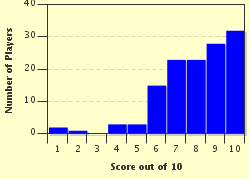Quiz Answer Key and Fun Facts
1. In which seminal maritime-themed novel does a character named Queequeg enjoy a bowl of soup "made of small juicy clams, scarcely bigger than hazelnuts, mixed with pounded ship biscuit, and salted pork cut up into little flakes; the whole enriched with butter, and plentifully seasoned with pepper and salt"?
2. One of the most famous dinners in literary history dates back from the 1st century AD. Who was the Roman author who wrote about Trimalchio's feast, during which "dormice seasoned with honey and poppy-seed" and "stuffed capons and sows' bellies, and in the middle, a hare equipped with wings to resemble Pegasus" (as well as other rather outlandish delicacies) were served to the guests?
3. "An exquisite scent of olives and oil and juice rose from the great brown dish as Marthe, with a little flourish, took the cover off. The cook had spent three days over that dish and she must take great care, Mrs. Ramsay thought..." In which rather slow-moving 20th-century novel would you find this mouth-watering description?
4. "There never was such a goose. Bob said he didn't believe there ever was such a goose cooked. Its tenderness and flavour, size and cheapness, were the themes of universal admiration. Eked out by apple-sauce and mashed potatoes, it was a sufficient dinner for the whole family; indeed, as Mrs Cratchit said with great delight (surveying one small atom of bone upon the dish), they hadn't ate it all particular, were steeped in sage and onion to the eyebrows!" Which iconic 19th-century novel features this heartwarming dinner scene?
5. "'It is a hole as big as thy head,' said the woman fretfully. But she filled it, none the less, with good, steaming vegetable curry, clapped a dried cake atop, and a morsel of clarified butter on the cake, dabbed a lump of sour tamarind conserve at the side; and Kim looked at the load lovingly." Which Nobel Prize-winning author wrote the novel "Kim", which includes this tantalizing description of an exotic meal?
6. The protagonist of this monumental early 20th-century novel, which chronicles a day in his life, is introduced as someone who "ate with relish the inner organs of beasts and fowls. He liked thick giblet soup, nutty gizzards, a stuffed roast heart, liver slices fried with crustcrumbs, fried hencod's roes."
7. "In a twinkling the table was laid. There was hot soup, cold meats, a blackberry tart, new loaves, slabs of butter, and half a ripe cheese: good plain food, as good as the Shire could show, and homelike enough to dispel the last of Sam's misgivings (already much relieved by the excellence of the beer)." In which highly influential fantasy tale would you find a group of four friends sitting down to such an appetizing meal?
8. "But it was upon the table that the cheeses appeared in greatest profusion. Here, by the side of the pound-rolls of butter lying on white-beet leaves, spread a gigantic Cantal cheese, cloven here and there as by an axe; then came a golden-hued Cheshire, and next a Gruyère, resembling a wheel fallen from some barbarian chariot..." This passage belongs to a longer episode, known as "The Cheese Symphony", in "The Belly of Paris", a novel by which great 19th-century French author - known for his involvement in the Dreyfus affair?
9. Southern food at its finest! In which beloved, Pulitzer Prize-winning novel would you come across a table "loaded with enough food to bury the family: hunks of salt pork, tomatoes, beans, even scuppernongs. Atticus grinned when he found a jar of pickled pigs' knuckles"?
10. "Dickon made the stimulating discovery that in the wood in the park outside the garden where Mary had first found him piping to the wild creatures there was a deep little hollow where you could build a sort of tiny oven with stones and roast potatoes and eggs in it. Roasted eggs were a previously unknown luxury and very hot potatoes with salt and fresh butter in them were fit for a woodland king-besides being deliciously satisfying." In which classic children's novel would two of the main characters enjoy such a simple yet tasty meal?
Source: Author
LadyNym
This quiz was reviewed by FunTrivia editor
MotherGoose before going online.
Any errors found in FunTrivia content are routinely corrected through our feedback system.

